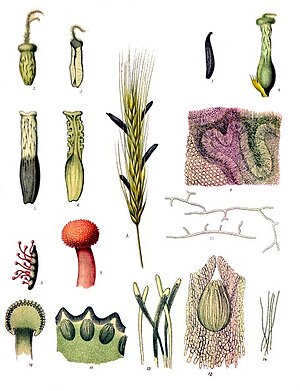Purple-brown ergot fungus
| Purple-brown ergot fungus | ||||||||||||
|---|---|---|---|---|---|---|---|---|---|---|---|---|

Forms of vegetation of the purple-brown ergot fungus |
||||||||||||
| Systematics | ||||||||||||
|
||||||||||||
| Scientific name | ||||||||||||
| Claviceps purpurea | ||||||||||||
| ( Fr .: Fr.) Tul. | ||||||||||||
| Varieties | ||||||||||||
|
Ecological group:
|
The purple-brown ergot fungus ( Claviceps purpurea ), also called ergot fungus for simplicity , is a sac fungus belonging to the genus of ergot fungi ( Claviceps ) that grows and parasitizes on rye and other sweet grasses . An infection of the ears of the grass can be recognized by the purple to black sclerotia , the mother grains , formed by the ergot fungus . The term ergot was associated with the effect of the fungus on the uterus, for example when it causes labor. In the 17th century, the drug was introduced into the practice of healers or bathers .
ecology
Claviceps purpurea is particularly found in regions with a temperate climate. In contrast to most of the other members of its genus, Claviceps purpurea shows only a relatively low host specificity. In addition to rye, the preferred host plant , ergot fungus also parasitizes on other types of grain , including triticale , wheat , oats and barley , as well as on wild grasses such as couch grass , salmon or field foxtail grass . This low selectivity enables the fungus to survive on wild grasses on the field after the grain harvest and to spread again after the next sowing.
Reproduction

It was not until 1853 that the French mycologist Louis René Tulasne described the complete cycle of the fungus Claviceps purpurea . The purple-brown ergot fungus is capable of sexual (sexual) and asexual (asexual) reproduction . As with all sac fungi, the haploid phase predominates . A diploid phase only plays a role for a short time in sexual reproduction.
Primary infection (sexual)
At the time of ripening, the sclerotia fall to the ground together with the grains and hibernate. In the following spring, several stalked, head-like fruiting bodies with numerous perithecia develop from the sclerotium with the fusion of compatible hyphae . Each perithecium forms numerous tubular asci inside , each of which produces eight haploid ascospores with meiotic divisions . At the time of grass and cereal flowering ascospores are released and spread by the wind and penetrate the germ tubes over the scars of unfertilized flowers in the ovary one. This type of infection is also known as primary infection.
Secondary infection (asexual)
During the sphacelia stage, before the formation of the sclerotium, the mycelium of the purple-brown ergot fungus develop into the conidiospores by constricting hyphae . These conidiospores are spread by rubbing between the ears, by rain, wind or by insects. The latter are attracted by a sweet liquid, which resembles honeydew , which is formed by the purple-brown ergot fungus through the decomposition of the grain seeds. Similar to ascospores, the conidiospores enter the fruiting bodies of flowering grasses. The importance of insects in secondary infection is particularly important.
Formation of the sclerotium
After infection of the fruiting bodies of flowering grasses, the spores form a fungal mycelium. In the Sphacelia stage, this grows through the ovary to form a soft white mass. Later, the honeydew comes out of it with decomposition of the fruit. The mycelium finally matures into a horn-like, dark purple to black sclerotium, the permanent form of the ergot fungus.
cultivation
The ergot fungus can be cultivated by infecting grain fields (parasitic culture) or in vitro (saprophytic culture). Its cultivation is used to obtain the drug ergot and the ergot alkaloids to be obtained from it .
Outdoor culture
The parasitic culture is carried out by inoculating rye or triticale plants with a conidia suspension obtained from an in vitro culture with the aid of inoculation machines shortly after the ears emerge from the surrounding bracts. After the grain has been harvested, the grains infected by the purple-brown ergot fungus can be picked out by machine. The method of parasitic culture is hardly of any importance today due to health risks.
In vitro culture
To obtain the ergot alkaloids produced by the purple-brown ergot fungus, saprophytic in-vitro culture methods using selected Claviceps purpurea strains, which are capable of alkaloid production under these conditions, are used today. The best yields are achieved with the help of submerged fermentation using various growth and production media . Ergot fungus can also be cultivated on agar media on a laboratory scale .
Model of an ergot fungus, Greifswald Botanical Museum
Individual evidence
- ↑ Pažoutová et al., 2000: Chemoraces and Habitat Specialization of Claviceps purpurea Populations.
- ↑ Douhan et al., 2008: Multigene analysis suggests ecological speciation in the fungal pathogen Clavicepes purpurea.
- ^ LR Tulasne : Mémoire sur l'ergot des glumacés. In: Annales des sciences naturelles (Partie Botanique). 20, 1853, pp. 5–56 (digitized version )
- ^ Butler MD, Alderman SC et al., 2001: Association of insects and ergot (Claviceps purpurea) in Kentucky bluegrass seed production fields.
- ↑ H. Mielke, 1993: Investigations to combat ergot. In: Nachrichtenbl. Deut. Plant protection / Braunschweig. 45, 5/6, pp. 97-102.
- ^ Éva Németh: Ergot. The genus claviceps . Ed .: Vladimir Křen, Ladislav Cvak (= Medicinal and aromatic plants - industrial profiles . Volume 6 ). Harwood Academic, Amsterdam 1999, ISBN 90-5702-375-X , Parasitic Production of Ergot Alkaloids, pp. 303-320 (English, crcnetbase.com ).
- ^ Malinka Zdeněk: Ergot. The genus claviceps . Ed .: Vladimir Křen, Ladislav Cvak (= Medicinal and aromatic plants - industrial profiles . Volume 6 ). Harwood Academic, Amsterdam 1999, ISBN 90-5702-375-X , Saphrophytic Cultivation of Claviceps, pp. 321-372 (English, crcnetbase.com ).



